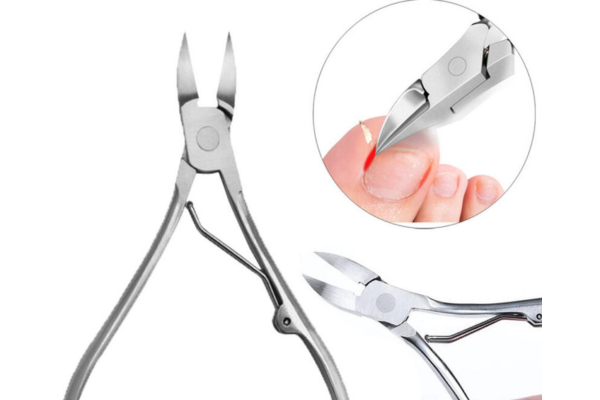Are you passionate about nail care and grooming? Do you ever find yourself standing in the grooming tools aisle, wondering which tool is best suited for your specific nail needs? If so, you've come to the right place! In today's exploration, we will embark on a journey to unravel the intriguing world of nail care by delving into the subtle yet significant distinctions between two essential tools: Toe nail nippers and cuticle nippers.
Whether you're a nail enthusiast or someone seeking to enhance your grooming routine, Nghia Nippers will provide valuable insights into these indispensable grooming companions. So, let's dive in and discover what sets toe nail nippers and cuticle nippers apart, helping you make informed choices for your nail care needs.

1. The difference between toe nail nippers and cuticle nippers
When it comes to nail care, having the right tools for the job can make a significant difference in the outcome. Two essential grooming tools for nail care are toe nail nippers and cuticle nippers. Let’s explore the key distinctions between these two tools and their specific purposes.
1.1 What is a toenail nipper?
Toe nail nippers are a type of grooming tool used to trim and maintain toenails. They are similar in function to regular nail clippers but are specifically designed to handle the thicker and tougher nails found on the toes. Toe nail nippers typically have a sturdy construction with sharp, curved blades that allow for precise cutting of toenails. They come in various sizes and designs, but they all serve the purpose of safely and effectively trimming toenails to keep them neat and prevent issues like ingrown toenails. These tools are commonly used in personal hygiene and pedicure routines.

1.2 What is a cuticle nipper ?
A cuticle nipper is a specialized grooming tool used for the precise maintenance of cuticles. Cuticles are the thin, delicate strips of skin that surround the base of your nails, protecting the nail matrix and preventing infections. Cuticle nippers are designed to trim excess cuticle skin and to remove hangnails, helping to keep the nails and surrounding skin neat and healthy.
Key features of a cuticle nipper typically include:
- Narrow, Pointed Jaws: Cuticle nippers have a slender and pointed jaw that allows for precise cutting of small pieces of cuticle skin or the removal of hangnails. The pointed tip enables you to target specific areas with accuracy.
- Sharp Cutting Edge: The cutting edge of a cuticle nipper is sharp, ensuring clean and precise cuts. This is crucial for avoiding any damage to the surrounding skin.
Using a cuticle nipper involves gently grasping the excess cuticle or hangnail with the tool's jaws and carefully cutting it away. It's important to exercise caution and not cut too much, as excessive trimming can lead to injury or irritation.
Cuticle nippers come in various sizes and designs to accommodate different preferences and needs. Some may have spring-loaded handles for ease of use, while others may be more basic in their design.
A cuticle nipper is a grooming tool specifically designed for the careful maintenance of cuticles and the removal of hangnails. It helps to keep the nail area looking tidy and promotes overall nail and finger health.

2. How to use toe nail nippers ?
Using toe nail nippers properly is essential to achieve a clean and safe toenail trimming experience. Here is a step-by-step guide on how to use toe nail nippers:
- Ensure that your toe nail nippers are clean and in good condition. If they are dirty, clean them with warm, soapy water, and disinfect them with alcohol or a sterilizing solution.
- Soak your feet in warm water for about 10-15 minutes to soften the toenails. This makes them easier to trim and reduces the risk of splintering.
- After soaking, thoroughly dry your feet with a clean towel. Moisture can make the nail slippery and challenging to cut accurately.
- Select the toenail you want to trim first. Make sure you have adequate lighting to see clearly.
- Grasp the toenail clipper firmly but not too tightly, ensuring you have a stable grip.
- Align the straight cutting edge of the toenail clipper with the toenail you intend to trim. Ensure that the curved jaw is facing upward.
- Gently squeeze the handles of the toenail clipper together, making sure to apply even pressure. Start from one end of the nail and move toward the other end in a smooth, controlled motion.
- Be cautious not to trim the toenail too short, as this can lead to ingrown toenails or discomfort. Leave a small margin of white nail beyond the tip of your toe.
- Continue this process for each toenail, one at a time.
- After trimming, inspect your toenails for any rough or jagged edges. If you notice any, use a nail file to gently smooth them out.
>>> Read more: How to cut ingrown toenail
- Clean your toe nail nippers after use and store them in a dry, clean place to prevent rust or contamination.
- Maintain proper hygiene by regularly cleaning your toe nail nippers and ensuring they are in good working condition. Replace them if they become dull or damaged.

3. Can You Use Cuticle Nippers To Cut Toenails?
Cuticle nippers are not designed for cutting toenails, and it is not advisable to use them for this purpose. While both cuticle nippers and toenail clippers are grooming tools, they serve very different functions, and using the wrong tool for a specific task can lead to problems and potential injury. Here's why you should not use cuticle nippers to cut toenails:
- Different Designs: Cuticle nippers have a slender, pointed jaw with a sharp cutting edge, making them suitable for precise work on small areas like cuticles and hangnails. Toenail clippers, on the other hand, have a curved, wide jaw with a straight cutting edge, designed for efficiently trimming toenails.
- Safety Concerns: Using cuticle nippers to cut toenails can result in uneven and jagged cuts, which may lead to ingrown toenails, nail damage, or injury. The sharp, pointed jaws of cuticle nippers are not intended for the larger and thicker toenails.
- Ineffectiveness: Cuticle nippers are not designed to handle the thickness and strength of toenails. Attempting to use them on toenails may require more effort and can still result in an unsatisfactory trim.
To properly care for your toenails and achieve a clean and safe trim, it is best to use toenail clippers specifically designed for this purpose. Toenail clippers provide a more effective and efficient way to trim toenails without the risk of complications. Always use the right tool for the job to maintain the health and appearance of your toenails.
4. Product preservation and hygiene
Preserving the hygiene and longevity of grooming tools like toenail nipper is crucial to ensure safe and effective nail care. Here are some tips for product preservation and hygiene:
- After each use, clean your toenail nippers or toenail clippers thoroughly. Use warm, soapy water to remove any nail debris, dirt, or oils from the tool's surface.
- To eliminate bacteria and prevent contamination, disinfect your tools. You can use isopropyl alcohol or a specialized sterilizing solution. Soak the tools for a few minutes, then rinse and dry them.
- After cleaning and disinfecting, ensure that your tools are completely dry before storing them. Moisture can lead to rust and the growth of bacteria.
- Store your grooming tools in a clean, dry place. Consider using a dedicated storage container or pouch to keep them protected and separate from other items.
- Keep an eye on the condition of your toe nail nippers and clippers. If you notice any signs of damage, such as dull blades or rust, it's time to replace them. Dull tools can cause injury or result in uneven nail trimming.
- Personal grooming tools should not be shared with others. Sharing tools can transmit infections or fungi, even after proper cleaning. Each person should have their own set of tools.
- Regularly check the sharpness of the cutting edges. Dull blades can make the trimming process more difficult and less effective. If necessary, use a sharpening tool or replace the blades.
- Prioritize hygiene when using your grooming tools. Wash your hands and clean your nails before trimming. This reduces the risk of introducing bacteria or contaminants during the process.
- If your grooming tools come with specific care instructions from the manufacturer, be sure to follow them to ensure product longevity.
- Periodically inspect your grooming tools for any signs of wear, such as loose parts or misalignment. Address any issues promptly to prevent accidents.
Understanding the difference between toe nail nippers and cuticle nippers is essential for effective nail care. Toenail clippers are designed for trimming toenails, while cuticle nippers are used to maintain cuticles. Using the appropriate tool for each task ensures a safe and precise grooming experience. By adhering to proper hygiene and care principles, as outlined by Nghia Nippers, you can maintain the longevity and effectiveness of these essential grooming tools.
News on the same topic: Toenail clippers for thick nails













